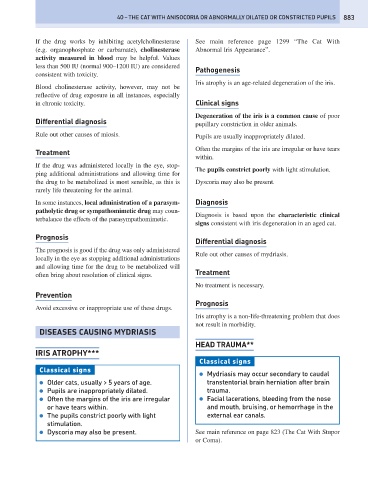Page 891 - Problem-Based Feline Medicine
P. 891
40 – THE CAT WITH ANISOCORIA OR ABNORMALLY DILATED OR CONSTRICTED PUPILS 883
If the drug works by inhibiting acetylcholinesterase See main reference page 1299 “The Cat With
(e.g. organophosphate or carbamate), cholinesterase Abnormal Iris Appearance”.
activity measured in blood may be helpful. Values
less than 500 IU (normal 900–1200 IU) are considered
Pathogenesis
consistent with toxicity.
Iris atrophy is an age-related degeneration of the iris.
Blood cholinesterase activity, however, may not be
reflective of drug exposure in all instances, especially
in chronic toxicity. Clinical signs
Degeneration of the iris is a common cause of poor
Differential diagnosis pupillary constriction in older animals.
Rule out other causes of miosis. Pupils are usually inappropriately dilated.
Often the margins of the iris are irregular or have tears
Treatment
within.
If the drug was administered locally in the eye, stop-
The pupils constrict poorly with light stimulation.
ping additional administrations and allowing time for
the drug to be metabolized is most sensible, as this is Dyscoria may also be present.
rarely life threatening for the animal.
In some instances, local administration of a parasym- Diagnosis
patholytic drug or sympathomimetic drug may coun-
Diagnosis is based upon the characteristic clinical
terbalance the effects of the parasympathomimetic.
signs consistent with iris degeneration in an aged cat.
Prognosis
Differential diagnosis
The prognosis is good if the drug was only administered
Rule out other causes of mydriasis.
locally in the eye as stopping additional administrations
and allowing time for the drug to be metabolized will
Treatment
often bring about resolution of clinical signs.
No treatment is necessary.
Prevention
Prognosis
Avoid excessive or inappropriate use of these drugs.
Iris atrophy is a non-life-threatening problem that does
not result in morbidity.
DISEASES CAUSING MYDRIASIS
HEAD TRAUMA**
IRIS ATROPHY***
Classical signs
Classical signs
● Mydriasis may occur secondary to caudal
● Older cats, usually > 5 years of age. transtentorial brain herniation after brain
● Pupils are inappropriately dilated. trauma.
● Often the margins of the iris are irregular ● Facial lacerations, bleeding from the nose
or have tears within. and mouth, bruising, or hemorrhage in the
● The pupils constrict poorly with light external ear canals.
stimulation.
● Dyscoria may also be present. See main reference on page 823 (The Cat With Stupor
or Coma).

